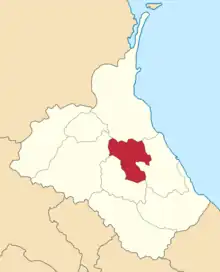Darginsky okrug
The Darginsky okrug[lower-alpha 1] was a district (okrug) of the Dagestan Oblast of the Caucasus Viceroyalty of the Russian Empire. The area of the Darginsky okrug is included in contemporary Dagestan of the Russian Federation. The district's administrative centre was Levashi.[1]
Darginsky okrug
Даргинскій округъ | |
|---|---|
 Location in the Dagestan Oblast | |
| Country | Russian Empire |
| Viceroyalty | Caucasus |
| Oblast | Dagestan |
| Established | 1854 |
| Abolished | 1928 |
| Capital | Levashi |
| Area | |
| • Total | 1,735.83 km2 (670.21 sq mi) |
| Population (1916) | |
| • Total | 85,131 |
| • Density | 49/km2 (130/sq mi) |
| • Rural | 100.00% |
Administrative divisions
The subcounties (uchastoks) of the Darginsky okrug were as follows:[2]
| Uchastok | 1912 population | Area |
|---|---|---|
| Akushinskiy uchastok (Акушиинскій участокъ) | 30,280 | 517.05 square versts (588.44 km2; 227.20 sq mi) |
| Mekeginskiy uchastok (Мекегинскій участокъ) | 22,235 | 403.49 square versts (459.20 km2; 177.30 sq mi) |
| Syurginskiy uchastok (Сюргинскій участокъ) | 17,175 | 291.51 square versts (331.76 km2; 128.09 sq mi) |
| Tsudakharskiy uchastok (Цудахарскій участокъ) | 11,060 | 313.54 square versts (356.83 km2; 137.77 sq mi) |
Demographics
Russian Empire Census
According to the Russian Empire Census, the Darginsky okrug had a population of 80,943 on 28 January [O.S. 15 January] 1897, including 38,403 men and 42,540 women. The majority of the population indicated Dargin to be their mother tongue.[3]
| Language | Native speakers | % |
|---|---|---|
| Dargin | 73,899 | 91.30 |
| Kazi-Kumukh | 3,739 | 4.62 |
| Avar-Andean | 3,131 | 3.87 |
| Russian | 57 | 0.07 |
| Polish | 29 | 0.04 |
| Georgian | 20 | 0.02 |
| Jewish | 19 | 0.02 |
| Ukrainian | 15 | 0.02 |
| Kyurin | 9 | 0.01 |
| Tatar[lower-alpha 2] | 8 | 0.01 |
| Lithuanian | 2 | 0.00 |
| Armenian | 1 | 0.00 |
| German | 1 | 0.00 |
| Other | 13 | 0.02 |
| TOTAL | 80,943 | 100.00 |
Kavkazskiy kalendar
According to the 1917 publication of Kavkazskiy kalendar, the Darginsky okrug had a population of 85,131 on 14 January [O.S. 1 January] 1916, including 42,156 men and 42,975 women, 85,020 of whom were the permanent population, and 111 were temporary residents:[6]
| Nationality | Number | % |
|---|---|---|
| North Caucasians | 85,108 | 99.97 |
| Russians | 23 | 0.03 |
| TOTAL | 85,131 | 100.00 |
Notes
-
- Russian: Дарги́нский о́круг, pre-reform orthography: Дарги́нскій о́кругъ, romanized: Dargínsky ókrug
- Before 1918, Azerbaijanis were generally known as "Tatars". This term, employed by the Russians, referred to Turkic-speaking Muslims of the South Caucasus. After 1918, with the establishment of the Azerbaijan Democratic Republic and "especially during the Soviet era", the Tatar group identified itself as "Azerbaijani".[4][5]
References
- Tsutsiev 2014.
- Кавказский календарь на 1913 год, pp. 144–151.
- "Демоскоп Weekly - Приложение. Справочник статистических показателей". www.demoscope.ru. Retrieved 2022-07-07.
- Bournoutian 2018, p. 35 (note 25).
- Tsutsiev 2014, p. 50.
- Кавказский календарь на 1917 год, pp. 186–193.
Bibliography
- Bournoutian, George A. (2018). Armenia and Imperial Decline: The Yerevan Province, 1900–1914. Milton Park, Abingdon, Oxon: Routledge. ISBN 978-1-351-06260-2. OCLC 1037283914.
- Кавказский календарь на 1913 год [Caucasian calendar for 1913] (in Russian) (68th ed.). Tiflis: Tipografiya kantselyarii Ye.I.V. na Kavkaze, kazenny dom. 1913. Archived from the original on 19 April 2022.
- Кавказский календарь на 1917 год [Caucasian calendar for 1917] (in Russian) (72nd ed.). Tiflis: Tipografiya kantselyarii Ye.I.V. na Kavkaze, kazenny dom. 1917. Archived from the original on 4 November 2021.
- Tsutsiev, Arthur (2014). Atlas of the Ethno-Political History of the Caucasus (PDF). Translated by Nora Seligman Favorov. New Haven: Yale University Press. ISBN 9780300153088. Archived (PDF) from the original on 17 June 2023.